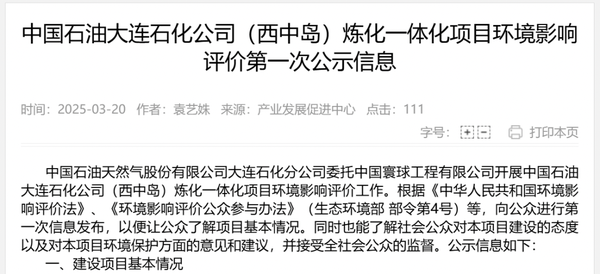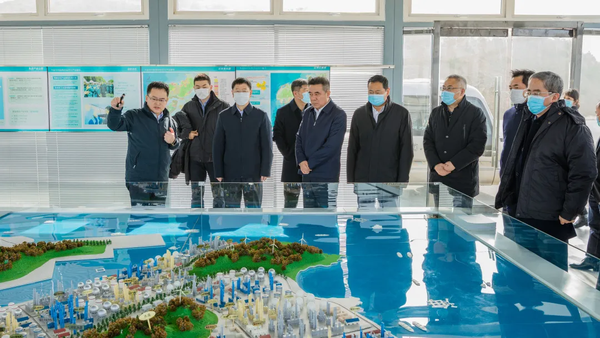700 billion yuan investment made in Liaoning's integrated starch-making and refining project
On March 20, 2025, the Longxing Island Economic and Technological Development Zone in Dalian released the first notification of the environmental impact assessment for the construction project of China Petroleum Dalian Petroleum Chemical Company (West Zhong Island) integrated refining and chemicals project, which injects new vitality into local economic development and brings multiple positive impacts to polyester and its downstream products.

Raw Material Supply: The Stable Foundation of the Polyester Industry
The project plans to construct a 10 million tons per year refinery, a 1.4 million tons per year ethylene plant, and its downstream facilities.

乙烯是聚酯行业的基础原料,增加产量意味着更充足的原料供应,稳定原料供应可以减少生产计划调整、成本增加等问题。
Similar to the Ji Jiang petrochemical industrial park, which through an integrated refining and petrochemical project, utilizes benzene products from Ji Jiang refining as raw materials to develop downstream petrochemical industries, forming a complete refining petrochemical integrated chain, increasing annual revenues by 600 billion yuan, becoming a 100 billion yuan chemical industrial park in Jiangxi province and a first-class green and intelligent petrochemical base in Central China. The Dalian petrochemical project will also increase the supply of benzene and other basic chemical raw materials, providing stable raw material support for polyester and downstream products.
Optimizing the Plastics Industry Chain: Enhancing Competitive Advantage The plastics industry is a complex and competitive market, where companies need to optimize their production processes to stay ahead of the competition. One key strategy to achieve this is by identifying and optimizing the industrial chain, particularly the aggregation of raw materials, production, and distribution. The plastics industry chain consists of several stages, including: 1. Raw material sourcing: Suppliers of raw materials such as ethylene, propylene, and other chemicals. 2. Production: Manufacturing of plastics products, including injection molding, extrusion, and other processes. 3. Distribution: Transportation and storage of finished products to retailers and customers. To enhance competitive advantage, companies in the plastics industry can take several steps: 1. Improve raw material sourcing: Companies can explore alternative suppliers, negotiate better prices, and optimize their supply chains to reduce costs. 2. Optimize production processes: Companies can implement lean manufacturing techniques, streamline their production lines, and improve product quality to reduce waste and increase efficiency. 3. Enhance logistics and transportation: Companies can optimize their distribution networks, reduce transportation costs, and improve delivery times to increase customer satisfaction. 4. Invest in digital technologies: Companies can leverage digital technologies such as artificial intelligence, data analytics, and the Internet of Things (IoT) to improve their supply chain management, reduce costs, and increase efficiency. By implementing these strategies, companies in the plastics industry can enhance their competitive advantage, improve their bottom line, and stay ahead of the competition.
The advancement of integrated refining and chemical projects helps optimize the cost structure of the polyester industry. On the one hand, the expansion of ethylene production capacity will change market supply and demand, and the price of ethylene is expected to stabilize or decrease, directly reducing the raw material procurement costs for polyester companies. On the other hand, integrated projects benefit from economies of scale and synergy, enabling efficient resource utilization and cost allocation in the production process. This cost advantage will be transmitted to the polyester and downstream product segments, enhancing the market competitiveness of the industrial chain. For example, downstream companies that use polyester products as raw materials can expand their market share at more competitive prices due to the reduced costs.
Nanjing Chemical Industrial Park has established a complete industrial chain with an integrated layout through scientific planning and coordination, creating an inter-supply relationship between enterprises in the park, significantly improving operational efficiency and reducing production costs for companies. The Daqing Chemical project adopts a similar approach; its integrated model reduces intermediate links, lowering logistics costs, and making polyester and downstream products more competitively priced.
Technological Innovation: Enhancement of Value Added in Polyester Products
The Dalian Petrochemical relocation project aims to develop a green, low-carbon, and efficient integrated refining and petrochemical project, promoting the innovative application of related technologies. In order to better utilize the high-quality raw materials and technical support provided by the new refining project, polyester and downstream companies will increase their R&D investments to develop high-value-added products. For example, they may produce polyester fibers with special properties for high-end apparel and high-performance industrial filter fabrics, or develop novel polyester composite materials for applications in electronics and automotive industries. These high-value-added products meet the market's demand for high-quality goods, thereby enhancing the profit margins along the polyester supply chain.
The full commercial operation of the Guangdong Petrochemical Integrated Refining and Chemicals Project will promote the upgrading of production technologies in China's domestic plastic industry. The project has adopted a large number of independently developed and domestically produced equipment, which will drive innovation and enhancement in the production technologies of China's domestic plastic industry, continuously improving product quality and production efficiency. Similarly, the Dalian Petrochemical Project will also promote the innovative application of related technologies. PET and downstream enterprises, in order to better utilize the high-quality raw materials and technical support provided by the new refining and chemical projects, will increase their R&D investments to develop high-value-added products.
Industrial Clusters: A New Engine for Regional Economic Development
The implementation of the project will change the product structure of petrochemicals in Dalian City, expanding from oil processing to a high-value-added industry chain in the midstream and downstream sectors, making it an important economic growth pole for Dalian City. In response to the basic chemical raw materials released by the relocation and transformation project of PetroChina Dalian Petrochemical, Dalian City has already reserved over 20 high-quality downstream projects. These projects gather to form an industrial cluster effect, enabling resource sharing, technology exchange, and collaborative innovation among polyester and downstream enterprises. For example, new technological achievements from a polyester company can be quickly promoted and applied among downstream enterprises within the cluster, accelerating the technological upgrading of the industry. At the same time, the industrial cluster attracts relevant supporting enterprises and talents, perfecting the industrial chain and enhancing the regional industrial competitiveness.
The Jiujiang Petrochemical Industry Park, based on a 300-kilometer radius around Jiujiang, has a demand for polyester raw materials exceeding 4 million tons per year. After the industrial chain is completed, it can achieve nearby supply, reducing procurement and logistics costs for downstream companies by more than 30%. The Dalian petrochemical project will also drive regional economic development, promoting resource integration through cluster effects, reinforcing and supplementing the industrial chain, achieving industrial transformation and upgrading, and promoting high-quality development of the park.
The advancement of the PetroChina Dalian Petrochemical Company (West Zhongdao) integrated refining and chemical project brings numerous positive impacts to polyester and its downstream products. These include enhanced feedstock supply stability, improved cost control and competitiveness, increased technological innovation and product added value, and the emergence of regional industrial cluster effects, driving the entire polyester value chain towards higher quality and greater competitiveness.
The company should actively cooperate with the new refining project, optimizing production processes and product structure. Governments and relevant institutions should continue to cultivate support industries clusters, perfecting infrastructure to create a favorable external environment for innovation development.
【Copyright and Disclaimer】The above information is collected and organized by PlastMatch. The copyright belongs to the original author. This article is reprinted for the purpose of providing more information, and it does not imply that PlastMatch endorses the views expressed in the article or guarantees its accuracy. If there are any errors in the source attribution or if your legitimate rights have been infringed, please contact us, and we will promptly correct or remove the content. If other media, websites, or individuals use the aforementioned content, they must clearly indicate the original source and origin of the work and assume legal responsibility on their own.
Most Popular
-

List Released! Mexico Announces 50% Tariff On 1,371 China Product Categories
-

Nissan Cuts Production of New Leaf EV in Half Due to Battery Shortage
-

New Breakthrough in Domestic Adiponitrile! Observing the Rise of China's Nylon Industry Chain from Tianchen Qixiang's Production
-

Dow, Wanhua, Huntsman Intensively Raise Prices! Who Controls the Global MDI Prices?
-

Mexico officially imposes tariffs on 1,400 chinese products, with rates up to 50%






